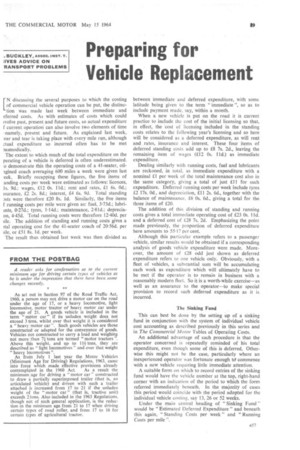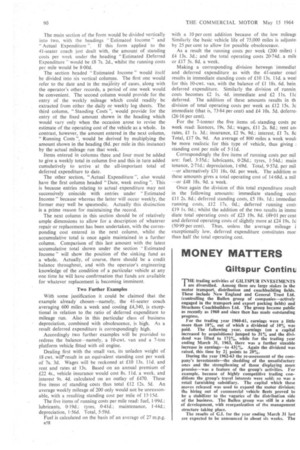Preparing for Vehicle Replacement
Page 91

Page 92

If you've noticed an error in this article please click here to report it so we can fix it.
[N discussing the several purposes to which the costing of commercial vehicle operation can be put, the distinction was made last week between immediate and eferred costs. As with estimates of costs which could kvolve past, present and future costs, so actual expenditure I' current operation can also involve two elements of time -namely, present and future. As explained last week, tar and tear is taking place with every mile run, although ctual expenditure so incurred often has to be met 5asmodically.
The extent to which much of the total expenditure on the perating of a vehicle is deferred is often underestimated. 'o demonstrate this the operating costs of a 41-seater, oilagined coach averaging 600 miles a week were given last 'eek. Briefly recapping these figures, the five items of anding costs per week were estimated as follows: licences, Is. 9d.; wages, £12 Os. lid.; rent and rates, £1 6s. Od.; isurance, £2 2s. 8d.; •interest, £4 6s. 9d. Total standing asts were therefore £20 8s. Id. Similarly, the five items f running costs per mite were given as: fuel, 3.73d.; lubrimats, 0.27d.; tyres, 1.14d.; maintenance, 2.81d.; depreciaon, 4.45d. Total running costs were therefore 12.40d. per tile. The addition of standing and running costs gives a )tai operating cost for the 41-seater coach of 20.56d. per tile, or £51 8s. id. per week.
The result thus obtained last week was then divided as
between immediate and deferred expenditure, with some latitude being given to the term "immediate ", so as to include payment made, say, within a month.
When a new vehicle is put on the road it is current practice to include the cost of the initial licensing so that, in effect, the 'cost of licensing ineluded in the standing costs relates to the following year's licensing• and so here will be considered as a deferred expenditure, as will rent and _rates, insurance and interest. These four items of deferred standing costs add up to £8 7s. 2d., leaving the remaining item of wages (£12 Os. 11d.) as immediate expenditure.
Dealing similarly with running costs, fuel and lubricants are reckoned, in total, as immediate expenditure with a nominal El per week of the total maintenance cost also in the same category, giving a total of just £11 for such expenditure. Deferred running costs per week include tyres £2 17s. Od., and depreciation, ill 2s. 6d., together with the balance of maintenance, £6 Os. 6d., giving a total for the three items of £2t1
The addition of this division of standing and running costs gives a total immediate operating cost of £23 Os. 11d. and a deferred cost of £28 7s, 2d. Emphasizing the point made previously, the proportion of deferred expenditure here amounts to 55.17 per cent.
Although this particular example refers to a passenger vehicle, similar results would be obtained if a corresponding analysis of goods vehicle expenditure were made. Moreover, the amount of £28 odd just shown as deferred expenditure refers to one vehicle only. Obviously,with a fleet of vehicles, a substantial sum will be accumulating each week as expenditure which will ultimately have to be met if the operator is to remain in business with a reasonably modern fleet. So it is a worth-while exercise—as well as an assurance to the operator—to make special provision to record such deferred expenditure as it is incurred.
The Sinking Fund This can best be done by the setting up of a sinking fund in conjunction with the system of individual vehicle cost accounting as described previously in this series and in The Commercial Motor Tables of Operating Costs.
An additional advantage of such procedure is that the operator concerned is repeatedly reminded of his total expenditure, even though some of this is deferred. Otherwise this might not be the case, particularly where an inexperienced operator was fortunate enough trt commence with a new vehicle requiring little immediate attention.
A suitable form on which to record entries of the sinking fund would have the vehicle number at the top, right-hand corner with an indication of the period to which the form referred immediately beneath. In the majority of cases this period would coincide with the period adopted for the individual vehicle costing, say 13, 26 or 52 weeks.
Under the main central heading of "Sinking Fund" would be "Estimated Deferred Expenditure" and beneath this again, "Standing Costs per week" and "Running Costs per mile ".
The main section of the form would be divided vertically into two, with the headings "Estimated Income" and " Actual Expenditure ". If this form applied to the 43-seater coach just dealt with, the amount of standing costs per week under the heading "Estimated Deferred Expenditure would be .£8 7s. 2d., whilst the running costs per mile would be 8-00d.
The section headed " Estimated Income " would itself be divided into six vertical columns. The first one would refer to the date and in the majOrity of cases, along with the operator's other records, a period of one week would be convenient. The second column would provide for the entry of the weekly mileage which could readily be extracted from either the daily or weekly log sheets. The third column, "Standing Costs ", would provide for the entry or the fixed amount shown in the heading which would vary only when the occasion arose to revise the estimate of the operating cost of the vehicle as a whole. In contrast, however, the amount entered in the next column, "Running Costs ", would be derived by multiplying the amount shown in the heading (8d. per mile in this instance) by the actual mileage run that week.
Items entered in columns three and four must be added to give a weekly total in column five and this in turn added cumulatively to arrive at the all-important total of deferred expenditure to date.
The other section, "Actual Expenditure ", also would have the first column headed "Date, week ending ". This is because entries relating to actual expenditure may not successively coincide with entries under "Estimated Income" because whereas the latter will occur weekly, the former may well be spasmodic. Actually this distinction is a prime reason for maintaining the record.
The next column in this section should be of relatively ample dimensions to allow for a description of whatever repair or replacement has been undertaken, with the corresponding cost entered in the next column, whilst the accumulative total is once again maintained in a further column. Comparison of this last amount with the latest accumulative total shown under the section " Estimated Income" will show the position of the sinking fund as a whole. Actually, of course, there should be a credit balance throughout, and with the operator's engineering knowledge of the condition of a particular vehicle at any one time he will have confirmation that funds are available for whatever replacement is becoming imminent.
Two Further Examples With some justification it could be claimed that the example already chosen-namely, the 41-seater coach averaging 600 miles a week and costing £4,340, is exceptional in relation to the ratio of deferred expenditure to mileage run. Also in this particular class of business depreciation, combined with obsolescence, is high. As a result deferred expenditure is correspondingly high.
Accordingly two further examples will be provided to redress the balance-namely, a 10-cwt. van and a 7-ton platform vehicle fitted with oil engine.
Dealing first with the small van, its unladen weight of 18 cwt. will result in an equivalent standing cost per week of 7s. 3d. Wages will be reckoned at £10 13s. lid, and rent and rates at 13s. Based on an annual premium of £22 4s., vehicle insurance would cost 8s. 11d, a week, and interest 9s. 4d. calculated on an outlay of £470. These five items of standing costs thus total £12 12s. 5d. An average weekly mileage of 200 only would not be unreasonable, with a resulting standing cost per mile of 15.15d.
The five items of running costs per mile read: fuel, 1-99d.; lubricants, 0.19d.: tyres, 0.41d.; maintenance, 1.44d.; depreciation, 1.56d. Total, 5-59d.
Fuel is calculated on the basis of an average of 27 m.p.g. 558 with a 10 per cent addition because of the low mileagE Similarly the basic vehicle life of 75,000 miles is adjuste by 25 per cent to allow for possible obsolescence.
As a result the running costs per week (200 miles) i £4 13s. 3d.; and the total operating costs 20.74d. a mill or £17 5s. 8d. a week.
Making a corresponding division between iinmediat and deferred expenditure as with the 41-seater coael results in immediate standing costs of £10 13s. lid, a wee for this 10-cwt. van, with the balance of £1 18s. 6d. bein deferred expenditure. Similarly the division of runnin costs becomes £2 Is. 4d. immediate and £2 us. 1 lc deferred. The addition of these amounts results in th division of total operating costs per week as £12 15s. 3c immediate (that is, 73.84 per cent) and £4 10s. 5d. deferro (26.16 per cent).
For the 7-tonner the five items of. standing costs pe week read: licences, 19s. 5d.; wages, £11 2s. 8d.; rent am rates, £1 Is. 3d.; insurance, £2 9s, 9d.; interest; £1 7s. Sc Total, £17 Os. 9d. An average of 800 miles a week wout be more realistic for this type of vehicle, thus giving standing cost per mile of 5-11d.
Correspondingly the five items of running costs per mil are: fuel, 3.35d.; lubricants, 0-28d.; tyres, 1-54d.; main tenance, 2-71d.: depreciation, 1-69d. Total, 9.57d. per mil ----or alternatively £31 18s. Od. per week. The addition a these amounts gives a total operating cost of 14-68d. a mil -or £48 18s. 9d. a week.
Once again the division of this total expenditure result in the following amounts: immediate standing cost £11 2s. 8d.; deferred standing costs, £5 18s. Id.; immediat running costs, £12 17s. Od.; deferred running cost £19 is. Od.; whilst the addition of the two results in imme diate total operating costs of £23 19s. 8d. (49.01 per cent and deferred operating costs of slightly more at £24 19s. (50.99 per cent). Thus, unless the average mileage i exceptionally low, deferred expenditure constitutes mor than half the total operating cost.




































































































































